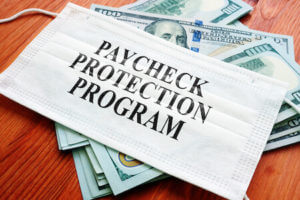
As a service to our clients, we have been keeping a close watch on the Paycheck Protection Program (PPP) and the recent amendments put in place with the signing of the Flexibility Act. Below is a summary of the most recent updates that have taken place, and what they mean for our clients.
I – The Best News of ALL: Changes to the Covered Period
Update:
Companies now have an 8-week or 24-week period to utilize their PPP loan.
The No-BS Financial Playbook for Small Business CEOs
Are you tired of making costly financial mistakes? Stop guessing and start growing. Learn how to create a scalable and valuable company while minimizing risk with this playbook from a serial entrepreneur who has been in your shoes.
Start Date:
Companies have the choice of starting their covered period with the loan disbursement date or the “alternative covered period” which is defined as the first day of their first pay period following their PPP Loan Disbursement Date. The alternative covered period allows a company to align their forgiveness calculation with their payroll cycle.
End Date: Two Options
- The earlier of the end of the 24 week period, or December 31, 2020.
- The end of the 8-week period
What does this mean for clients?
Your ability to obtain full forgiveness has greatly increased!! Unless you can utilize the entire loan amount with forgivable costs within 8 weeks, companies should take advantage of this change and utilize the 24-week covered period to help maximize their amount of forgiveness.
II – Slight Changes to the Forgivable Costs / Amounts
Forgivable Costs
Human Resource Infrastructure 360°™
Don’t let costly human resource issues creep up on you. Learn about the 5 components of HR Infrastructure 360°™ - our proprietary framework for building and supporting your team.
- Owners (and independent contractors) salaries are capped at $15,385 and $20,833 under the 8-week and 24-week covered periods, respectively.
- These capped totals are “per owner,” and inclusive of covered benefits.
- Employee salary up to $100,000. The forgiveness is capped at $15,385 and $46,154 under the 8-week and 24-week covered periods, respectively. Salary includes:
- Gross salary
- Tips
- Commissions
- Paid leave including vacation and family / medical / sick leave.
- Hazard pay
- Covered benefits for employees (but not owners and independent contractors) including:
- Health care expenses
- Retirement contributions
- State taxes imposed on employee payroll paid by the employer (such as unemployment insurance premiums).
Non-Payroll Costs / Utilities including:
- Rent
- Mortgage interest
- Utilities for which service began before 2/15/2020 – includes electricity, gas, water, telephone, internet access, transportation
- A nonpayroll cost is eligible for forgiveness if it was (i) paid during the covered period, or (ii) incurred during the covered period and paid on or before the next regular billing date, even if the billing date is after the covered period.
The ratio of forgivable costs
- The new Act requires a borrower to use at least 60% of the covered loan amount for payroll costs, and states that a borrower may use up to 40% for utilities.
- If a borrower uses less than 60% of the loan amount for payroll costs during the forgiveness covered period, the borrower will continue to be eligible for partial loan forgiveness.
- The maximum forgiveness amount is the total payroll costs divided by 60%
Use a Forgiveness Calculator
- We recommend the AICPA workbook (in Excel).
III – The Wage and FTE Reduction Exemption Date is now December 31, 2020
New Provision:
- The forgiven amount of a loan will be determined without regard to a reduction in FTEs that is due to an inability:
- To rehire individuals who were employees on February 15, and hire similarly qualified employees for unfilled positions on or before December 31, or
- To return to the same level of business activity at which the borrower was operating before February 15 due to compliance with requirements established or guidance issued by the Secretary of Health and Human Services, the CDC, or OSHA during the period of March 1 through December 31, related to maintenance of COVID-19-related standards for sanitation, social distancing or any other worker or customer safety requirement.
- In either case, to qualify for this additional safe harbor, borrowers must document, in good faith, their inability to rehire or hire employees, or to return to their pre-February 15, 2020 level of business activity, and be prepared to provide that documentation with their forgiveness applications.
IV – The Unforgiven Loan Balance
Loan Maturity:
- Companies have up to 10 months after their covered period to apply for forgiveness.
- Extended to 5 years repayment period
- No prepayment penalties
- Loan repayments of principal and interest will be deferred until SBA determines the amount of the loan that will be forgiven and pays that amount to the lender.
Loan Forbearance:
- The forbearance period (time you have to apply for forgiveness with your bank) is extended from 6 to 10 months.
- A company may apply for forgiveness before the 24-week coverage period ends if they have used all the funds on forgivable costs.
- The bank has 60 days to submit your request to the SBA
- The SBA has 90 days to submit their response and repay the bank
V – Deferral of Payroll Tax Payment
- The new Act permits PPP loan recipients who receive loan forgiveness to defer payroll tax payments for the entire March 27 – Dec. 31, 2020 period.
- Partner with your payroll service provider to administrate this benefit.
VI – The Process of Receiving Forgiveness
Work with your Lender, not the SBA:
- Contact your lender to understand their process
- Some banks might outsource this process, try to schedule with your CSR
Other Details:
- Companies must hold onto all supporting documents for six years
- Forgiven costs will not be tax-deductible, so plan accordingly for estimated payments.
- NOTE: This is a potentially big deal. Many people expect Congress to change this rule, but for now, this is how the IRS will treat expenses used by PPP loans.
The information presented here should not be construed as legal, tax, accounting, or valuation advice. No one should act on such information without appropriate professional advice and after a thorough examination of the particular situation
Related Reading:
PPP Loan Forgiveness – June 3 Update – Published June 9, 2020
Maximizing PPP Loan Forgiveness – You Received Your Funds, What You Should Do Now – Published April 27, 2020


